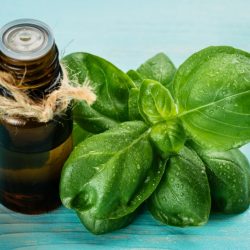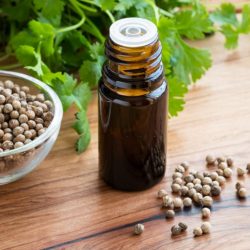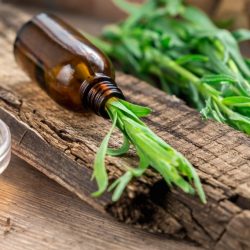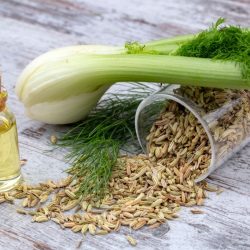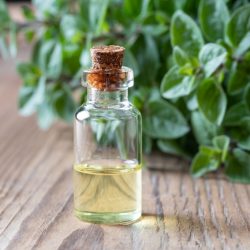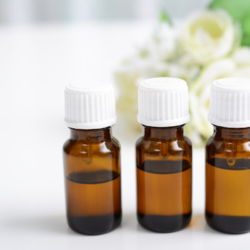The noble laurel, whose botanical name is Laurus nobilis, belongs to the Lauraceae family. Its essential oil is produced from its leaves (young leaves) and fruiting branches.
History of Noble Laurel
This tree has been venerated since ancient times by the Greeks and Romans. They adorned their emperor’s head with a laurel wreath. Dedicated to Apollo, it represents vitality, beauty and victory. A wreath of laurel berries(bacca laureati) was also given to young medical graduates. This tradition was to become the famous baccalaureate at the end of secondary school.
The leaves are appreciated as a flavouring in cooked dishes, hence the name laurel-sauce. The oil obtained from the berries is used, along with olive oil and samphire (vegetable soda), to make Aleppo soap. It gives it its “superfatted” quality. This is the oldest soap, made 3,500 years ago. Today, there’s not a single guidebook that fails to mention it, nor a single shop that would do it the injustice of not including it among its aromatic contingent.
A little mythology
In ancient times, the laurel had profound symbolic and ritual importance. The Pythia of Delphi, the famous oracle priestess, incorporated it into her divination rituals. It was also considered sacred by the Vestals, the priestesses of Vesta in Rome. Roman superstitions postulated that the wilting of the laurel was a harbinger of calamity. What’s more, during the Saturnalia celebrations in December, the Romans used to weave its foliage into garlands. The laurel was also associated with divine figures such as Apollo and Aesculapius. It’s worth noting that mythology recounts Daphne’s transformation into a laurel tree to escape Apollo’s advances. This reinforces the sacred nature of this plant in the ancient cultural context.
Should we be content with the Merchants’ Festival celebrated every 15 May in Rome, during which traders and merchants blessed all their wares with a laurel branch, as a reminder that the laurel is above all a plant ofHermes? Isn’t the colour of the aura of its essential oil blue? Doesn’t blue refer to the throat chakra, the seat of eloquence in all its forms? Isn’t laurel associated with the Muses – poetry, song and music, among others? Why, then, is Hermes so rarely mentioned in connection with the laurel, and the credit is given entirely to another divinity, Apollo? Probably because it wasn’t Hermes who pursued the nymph Daphne with his amorous intentions.
And this is where we get to the heart of the matter. In the Metamorphoses (Book I), Ovid addresses the question of the genesis of the laurel tree. A nymph, Daphne, daughter of Peneus, is the subject ofApollo‘s love affair, after Apollo mocksEros. In revenge, he thrust the perfidious sting of love into the heart of the god whose beauty was too seductive. His relentlessness pushed the nymph to the limit, and she begged the gods to change her shape in order to escapeApollo‘s insistent pleas. Daphne was the only nymph to resist him, “the only one, it seems, whom he loved, no doubt because of her refusal of all love”. Daphne became roots, trunk, branches, foliage… laurel.
What an inverted symbol, signalling not a victory but a failure for the god through this laurel, which seems to embody a certain idea of chastity. But what more could you expect from a nymph priestess ofArtemis? So Apollo laments: “Since you cannot be my wife, you will be my tree; you will adorn my hair, my zither and my quiver”. Faced with a persistent god, a nymph’s flight is not enough. The intervention of other deities is necessary for her transformation. However, even transformed into a tree, the nymph does not escape the attention of the spurned god. He then claimed the tree as a symbol of his unfulfilled lust.
Greek mythology raises questions about machismo and patriarchy. It also raises questions about sexual harassment. Apollo defeated the laurel, not Daphne. But his success is not complete. The story ends with a crown. Apollo braids it and places it on his head.
From then on, the laurel will remain inseparable fromApollo. However, this crown has a second origin. It was given to him after the death of Python. For Apollo, it was a purification. This led to the Pythian Games, held every eight years. The crown becomes a prize for the winners. Pythia and her pythonesses also keep the memory of Python alive. On a tripod adorned with laurel, they prophesied of vapours emanating from a nearby fault in the earth.
It is said that Pythia and her priestesses ate laurel leaves to enhance their visions. But were a few leaves enough? We know that laurel is narcotic, but it only acquires this property in high doses. Could it be that its cathartic power was made possible because it was consecrated to Apollo? Or did the henbane seeds, which were also used, have something to do with it? Quite possibly, not to mention the ‘toxic’ emanations from the earth, which put the Pythia in an ideal prophetic position.
Whatever the case, the visionary power of the laurel will live on. For example, the daughter of the soothsayer Tiresias, Manto, was also nicknamed Daphne. In his second Idyll, Theocritus describes the sorceress who seeks to detect omens in the crackling sound produced by burning laurel leaves, a technique that has become part of popular augury, where a noisily burning leaf is a sign of a good harvest, and a bad one otherwise. Other divinatory rituals also involved laurel: placing a branch of laurel under your pillow, with half a leaf in your mouth, ensured that you would receive the answer to a question in your dreams. Or this one, delivered by a magic papyrus: “Write on a laurel leaf with myrrh and the blood of a dead man who died a violent death […]: you are the one who knows everything in advance”.
Before turning to another aspect of the laurel, we should point out that only women were allowed to worship it. So Apollo was unable to appropriate the laurel directly. He only managed to link his cult to this oracular tree. In this way, the metamorphosis of Daphne also explains the desire of a new deity to take control of the ancient cult of the laurel tree, even though it is incomplete, as the Greek word for laurel is daphnai.
Eating laurel was not the exclusive preserve of the Pythia, since it was also done at the mysteries ofEleusis and those dedicated to Dionysus. The mystics ofEleusis used laurel because it was considered to be a plant that promoted continence(cf. the chastity of Daphne). So how can we explain the role played by laurel in Ovid’ sMetamorphoses(Book III): “the whole house, carpeted with laurel and lit with torches, resounded with the song of the hymen”. GivenApollo ‘s fiasco with Daphne, it is to be feared that marriage and laurel do not go well together.
However, here and there we find indications of its use in love. In the Petit Albert, there is a love ritual involving laurel leaves. In Corsica, laurel garlands adorned the house where the wedding took place, and so on. Perhaps the laurel has little to do with love, and we need to explain its presence here to ensure the success of the enterprise, the laurel being a symbol of victory.
In Thessaly, in the Tempé valley where the river Pénée flows, the Maenads performed a Dionysian cult by chewing on laurel leaves. This association between the vine symbolised by Dionysus and the laurel is extremely curious. Since at least the time of Theophrastus (4th century BC), we have been hearing explanations of the antipathy between plants in the manner of elephants and mice. Theophrastus, for example, explains that vines absorb the smell of laurel. But on the other hand, the motive is reversed, and the harmful effect of laurel on the vine is mentioned, leading Ibn El Baytar to say much later that laurel is a preventive remedy against drunkenness and that the Petit Albert contains a recipe for “restoring spoiled wine”, which includes laurel.
All this is very strange indeed, especially when you consider that the Maenads were nicknamed the Furious Ones. So how could they get ecstatically drunk if the laurel warded off the effects of the wine? In any case, this explains why the laurel was an attribute of Dionysus (and Bacchus). It was also an attribute ofAsclepius/Esculapius, son of Apollo.
This helps us to understand that in Poitou, not so long ago, peasants would go to mass carrying a branch of laurel in order to regain their health, which was sometimes possible through atonement: the laurel tree, which in Roman times adorned the palaces of emperors and pontiffs as a badge of glory and peace of arms and minds to last forever, formed one of the seven hills of Rome on theAventine hill, according to Ovid(Les fastes), laurel leaves were often crackling on altars long before the arrival of incense and myrrh.
If people were purified, so too were places, especially temples: the forecourt of the temple ofApollo at Delphi was purified with branches of laurel, the same branches that, according to Sozomen, were used by the first Christian priests to sprinkle those entering the temples. Purifying, laurel was also protective, warding off lightning, thunder and storms, and was often planted near homes and fields to ensure the safety of people and property.
Antiquity
Although it fringes the shores of the Mediterranean like a pair of eyelashes, this has not always been the case. The laurel grew mainly on human initiative from a point thought to be in Asia Minor. In Hesiod‘s time, in the eighth century BC, it was common in Boeotia and formed the main plant cover of the Tempé valley, through which the river Pénée flows.
It may therefore have been planted over 3,000 years ago by a pre-Hellenic society. Greek settlers then imported it to southern Italy, probably in the 6th and 5th centuries BC, since it is known to have been very common in Italy around the 4th century. The Romans brought it with them to Narbonne, the Iberian Peninsula and North Africa.
From Hippocrates, we learn that the use of bay leaves was not unknown to him: rubbing its oil weakened tetanus and its leaves soothed post-partum pains. Theophrastus, who was not a doctor, conceded an interest in it, being a botanist, but the use he made of it indicated some therapeutic knowledge about it: he “thought to remove from himself any contagious impurity by walking around the city all day, on the day of the feast of Choes, with a branch of laurel between his teeth, after having purified his hands and sprinkled himself with lustral water”.
Laurel has many uses. In addition to its medicinal properties, it is considered a “magical” plant. It offers protection against poisons and evil spells. The expression “I carry a stick of laurel” symbolises this protection. Nero took refuge in a laurel grove during a plague epidemic. Pliny adds a medical dimension. He advises chewing three leaves for three days to cure a cough. Dioscorides distinguishes between two species of laurel: broad-leaved and narrow-leaved.
Are they one species and one subspecies? Their warming and astringent properties relieve pain in the bladder and the womb, as well as that caused by insect bites and other inflammations. However, he warns that the leaves “taken as a drink […] offend the stomach and cause vomiting”, but we now know that this is only possible in excessively high doses. As for the berries, he used them mainly as a respiratory remedy (asthma, catarrh) and ENT remedy (ear pain; a property taken up by Serenus Sammonicus in the 3rd century AD). As for the bark of the laurel root, Dioscorides describes it as lithontriptic and abortifacient, a word that caused Dr Cazin to jump up and down in the 19th century, reproaching certain “pharmacologists” for claiming that laurel berries had the same power, when this was clearly not the case.
Finally, is bay laurel useful for liver disease? Certainly not. Was it lithontriptic? There is no further evidence of this. Was it “still used by Greek folk medicine as a specific remedy for tics and epilepsy “? Yes. Did it ever cure them? We don’t know, but since it is closely related to the nerves, we can assume that it did, being a mercurial plant, although it’s not Hermes we think of first when we think of laurel.
Middle Ages
The Apollonian and Mercurian laurel, because it celebrates poetic, artistic and musical improvisation, was also one of the sun plants. Very early on, it was noted that this tree with its igneous essence, as Proclus pointed out, had the virtue of lighting itself on fire by briskly rubbing two laurel branches onto which pulverised sulphur was thrown, a conjugation with the sun that has been reaffirmed many times(Henri Corneille Agrippa, Grand Albert, Petit Albert, etc.) and whose protection could be secured by proceeding as follows: “A knot should be prepared from laurel leaves and lion skin, which should be hung around the neck with a golden thread or a yellow silk thread”
Long after this grandeur and magnificence, the laurel, whatever one may say, no longer shines with the same splendour as it once did, although some poets, such as Thibault Lespleigney, still sing its praises: “In this tree virtue abounds, as much as in any tree of this world” The laurel was stripped of its sacred and ostentatious character, as a plant used for a multitude of purposes, but the tree was nevertheless retained as a medicinal plant throughout the Middle Ages and, interestingly enough, it was not content to be endowed with far-fetched properties: in the 9th century, the Iranian scholar Rhazes noted that laurel was useful for treating facial nervous twitches (its status as a plant of Mercury explains this action on the nerves); the Byzantine Nicolas Myrepsus (13th century) used the berries for their cough-relieving properties; and Hildegarde de Bingen said that laurel was warm and moderately dry, an image of constancy.
Hildegard used berries above all in her recipes to soothe aches and pains of all kinds (head, stomach, lungs, heart, kidneys, back, etc.). She also made use of their febrifuge and anti-gout qualities, even attributing to them a virtue for anger and cases of “dementia”.
Modern and contemporary times
Cazin (19th century) recommended the leaves as a digestive stimulant and carminative, and the berry powder as a menstrual stimulant. In the 20th century, Fournier recommended using the leaves in aromatic baths to treat rheumatic pains and sprains, and applying the powder to ulcers. Burnt leaves disinfect the atmosphere. They are used in folk medicine to treat mouth ulcers and abdominal pain. Aqueous extracts of berries are used as a healing agent. Berry oil is massaged to relieve rheumatic pain. It is applied to animals to combat parasites, and fresh leaves rubbed onto horses protect them from insects.
Worse still, in 1935, Botan wrote the following about it: “It is an aromatic stimulant with virtually no medical uses and is used almost exclusively to flavour our stews”. What a downfall, what a misappreciation, what a mistake to believe that laurel is worthless in medicine! Can we, in just a few lines, sweep away thousands of years of history in which laurel has played a part, not least from a medicinal point of view? No, such infamy cannot be tolerated!
After the Middle Ages, the therapeutic career of bay leaves stretched as long as a day without bread. To say that it has been neglected is not strong enough. why,” asks Gilibert, “should practitioners neglect a tree they have on hand, in order to make mysterious use of its Indian congeners? It’s an eternal refrain that every century finds someone to repeat (think of Cazin in the nineteenth century, Botan in the twentieth, etc.).
Exotic spices have long captivated Europe. This fascination was due to their rarity and novelty. There is also a myth that Europeans had few remedies before these imports. However, laurel has managed to distinguish itself. In the 19th century, its essential oil was well known but not very common. It is not specifically mentioned in Valnet’s work on aromatherapy.
Today, there is not a single guide that fails to mention it, not a single shop that would do it the injustice of not including it among its aromatic contingent. You only have to open your eyes to see that the laurel has spread well beyond the 45th parallel, since it can be found in Finistère as well as in the Paris region. However, these planted trees do not usually bear fruit. In spite of this, the laurel has spread throughout the world in many different ways, including medicinal and symbolic uses.
What are the pharmacological properties of Laurel leaf essential oil?
Laurel is an aromatic plant known for its culinary properties, but also for its medicinal properties. Bay leaves are used to produce essential oil, which has numerous pharmacological properties that are beneficial to health.
Antimicrobial properties :
Laurel essential oil is immunostimulant, bactericidal, virucidal and fungicidal. It is an anti-infectious agent with pulmonary and ENT tropism, with antibiofilm activity against Staphylococcus aureus . It is also antibacterial against Escherichia coli, Listeria monocytogenes and Salmonella typhimurium, and has been shown to have antiviral action, inhibiting replication of the SARS-CoV and HSV-1 viruses.
Analgesic and anti-inflammatory properties:
In vitro studies on monocytes have demonstrated the anti-inflammatory effect of 1,8-cineole against inducers such as interleukin-1β. It significantly reduces mediators of pulmonary inflammation, including arachidonic acid metabolites, leukotriene B, thromboxane-B and prostaglandin E, as well as TNF-α. Eugenol and MT carbides also contribute to this anti-inflammatory action.
Its analgesic, antineuralgic and anti-inflammatory effects are therefore comparable to those of morphine and piroxicam.
Antispasmodic properties :
Antispasmodic (complementary), the 1,8 cineole and terpenyl acetate that laurel essential oil contains act on the smooth muscles of the trachea in relation to acetylcholine. The ST lactones thus slow down gastric emptying.
Insecticidal properties :
Laurel’s insecticidal properties have been demonstrated against lice, mites and flour beetles. It is also a moth repellent.
Nervous system properties :
Neurotonic and cerebral stimulant, bay leaf essential oil regulates the vegetative nervous system (sympathetic and parasympathetic) with digestive tropism, as well as Ʃ
Laurel essential oil and self-confidence:
Noble Laurel is often associated with glory and success in ancient symbolism. According to aromatherapy, this essential oil is beneficial for self-confidence and for combating stress and anxiety. It is said to have an influence on courage, willpower and assertiveness. It is also said to help concentration and stimulate memory.
Other properties :
- Anti-sclerosing
- Lymphatic regulator
- Vaso-coronary-dilator
- Antidiabetic through alpha-glucosidase inhibition
- Antioxidant and antiproliferative against leukaemic cells (chronic myeloid leukaemia), antiproliferative activity against breast cancer cells (breast adenocarcinoma)
- Decontracting, especially when applied locally
- Anti-degenerative and anti-putrid
- Expectorant and mucolytic by stimulating the exocrine glands of the respiratory mucosa
Does Laurel essential oil require any precautions for use?
- Contraindicated in pregnant or breast-feeding women
- For adults only (risk of convulsions in children)
- Do not inhale, diffuse or add to bath water
- Do not combine with cortisone, risk of drug interaction, ask your pharmacist for advice
- Not recommended for asthmatics
- Not recommended for animals
- Contraindicated if you have a history of convulsions
- Caution in case of anti-epileptic treatment
Medical literature and clinical trials:
- Merghni A, Marzouki H, Hentati H, Aouni M, Mastouri M. Antibacterial and antibiofilm activities of Laurus nobilis L. essential oil against Staphylococcus aureus strains associated with oral infections. Pathol Biol (Paris). 2015
- Dadalioglu I, Evrendilek GA. Chemical compositions and antibacterial effects of essential oils of Turkish oregano (Origanum minutiflorum), bay laurel (Laurus nobilis), Spanish lavender (Lavandula stoechas L.), and fennel (Foeniculum vulgare) on common foodborne pathogens. J Agric Food Chem. 2004
- Loizzo MR, Saab AM, Tundis R, Statti GA, Menichini F, Lampronti I, Gambari R, Cinatl J, Doerr HW. Phytochemical analysis and in vitro antiviral activities of the essential oils of seven Lebanon species. Chem Biodivers. 2008
- Sayyah M, Saroukhani G, Peirovi A, Kamalinejad M. Analgesic and anti-inflammatory activity of the leaf essential oil of Laurus nobilis Linn. Phytother Res. 2003
- Sayyah M, Valizadeh J, Kamalinejad M. Anticonvulsant activity of the leaf essential oil of Laurus nobilis against pentylenetetrazole- and maximal electroshock-induced seizures. Phytomedicine. 2002
- Sahin Basak S, Candan F. Effect of Laurus nobilis L. Essential Oil and its Main Components on α-glucosidase and Reactive Oxygen Species Scavenging Activity. Iran J Pharm Res. 2013
- Matsubara E, Fukagawa M, Okamoto T, Fukuda A, Hayashi C, Ohnuki K, Shimizu K, Kondo R. Volatiles emitted from the leaves of Laurus nobilis L. improve vigilance performance in visual discrimination task. Biomed Res. 2011
- Saab AM, Tundis R, Loizzo MR, Lampronti I, Borgatti M, Gambari R, Menichini F, Esseily F, Menichini F. Antioxidant and antiproliferative activity of Laurus nobilis L. (Lauraceae) leaves and seeds essential oils against K562 human chronic myelogenous leukaemia cells. Nat Prod Res. 2012
- Al-Kalaldeh JZ, Abu-Dahab R, Afifi FU. Volatile oil composition and antiproliferative activity of Laurus nobilis, Origanum syriacum, Origanum vulgare, and Salvia triloba against human breast adenocarcinoma cells. Nutr Res. 2010


